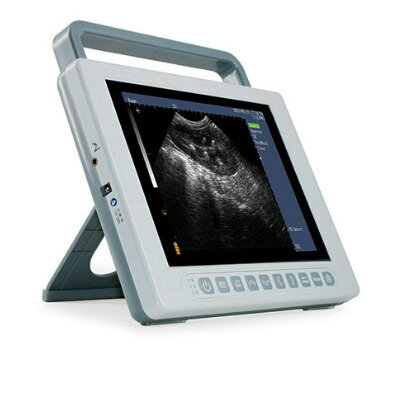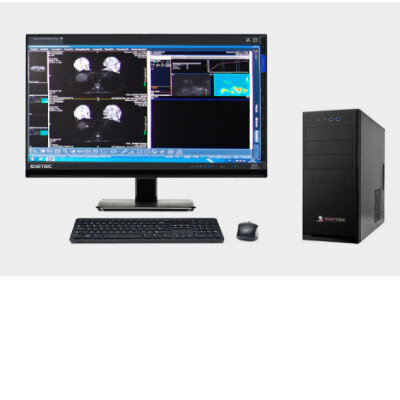Hyperscan Proton Therapy System Offers Pinpoint Accuracy
|
By MedImaging International staff writers Posted on 14 May 2018 |

Image: The S250i proton therapy system with Hyperscan PBS (Photo courtesy of Mevion Medial Systems/MedStar Georgetown).
An innovative Proton Therapy System improves on existing scanning capabilities and enables clinicians to deliver conformal fields faster and with more precision than in the past.
The Mevion Medical Systems (Mevion; Littleton, MA, USA) S250i Proton Therapy System with Hyperscan pencil beam scanning (PBS) shapes the delivered radiation dose by precisely targeting tumors with sub-atomic particles. To improve accuracy and speed, a robotically controlled adaptive aperture proton multi-leaf collimator (pMLC) is used, which trims the edges of the beam to achieve sharp lateral dose gradients. This capability can deliver up to a three times sharper drop off in radiation at the delivery field edge, sparing healthy tissue and limiting unnecessary radiation to sensitive locations.
By reducing delivery times to less than five seconds, errors resulting from target tumor shifting under normal organ motion, such as breathing, can be reduced. Other features of the S250i include a gantry mounted superconducting synchrocyclotron, a six degree-of-freedom treatment couch, and advanced in-room image guidance that creates a three-dimensional (3D) representation of the tumor and relays the information to the proton therapy device. The computerized tomography (CT) based imager can also be used to modify treatment in response to changes in the patient’s anatomy, such as tumor shrinkage.
“Proton therapy is an advanced form of radiation that can destroy cancer cells. A machine called a cyclotron speeds up protons to two thirds the speed of light and they become highly charged,” said radiation oncologist Peter Ahn, MD, of MedStar Georgetown (Washington DC, USA), which inaugurated the first system worldwide in April 2018. “Because we can more tightly control the protons than we are able with traditional radiation, proton therapy can be given without damaging critical tissues and structures near the tumor because the beam conforms precisely to the tumor’s size and shape.”
“Delivering sharp field edges has been a real challenge for PBS, especially in shallow fields. In intracranial procedures, where critical structures are in close proximity to tumors at shallow depths, having the sharpest lateral penumbra is essential,” said Skip Rosenthal, VP of clinical education at Mevion. “The sharp penumbras of the adaptive aperture system have substantial benefits for these patients. In addition, the enhanced speed of Hyperscan PBS could enable greater confidence in treating thoracic tumors.”
Proton therapy is a precise form of radiotherapy (RT) that uses charged particles instead of x-rays. It can be a more effective form of treatment than conventional RT as it directs the beam more precisely, with minimal damage to surrounding tissue. Evidence is growing that protons can be effective in treating a number of cancers, in particular children and young people with brain tumors, for whom it appears to produce fewer side effects such as secondary cancers, growth deformity, hearing loss, and learning difficulties.
Related Links:
Mevion Medical Systems
The Mevion Medical Systems (Mevion; Littleton, MA, USA) S250i Proton Therapy System with Hyperscan pencil beam scanning (PBS) shapes the delivered radiation dose by precisely targeting tumors with sub-atomic particles. To improve accuracy and speed, a robotically controlled adaptive aperture proton multi-leaf collimator (pMLC) is used, which trims the edges of the beam to achieve sharp lateral dose gradients. This capability can deliver up to a three times sharper drop off in radiation at the delivery field edge, sparing healthy tissue and limiting unnecessary radiation to sensitive locations.
By reducing delivery times to less than five seconds, errors resulting from target tumor shifting under normal organ motion, such as breathing, can be reduced. Other features of the S250i include a gantry mounted superconducting synchrocyclotron, a six degree-of-freedom treatment couch, and advanced in-room image guidance that creates a three-dimensional (3D) representation of the tumor and relays the information to the proton therapy device. The computerized tomography (CT) based imager can also be used to modify treatment in response to changes in the patient’s anatomy, such as tumor shrinkage.
“Proton therapy is an advanced form of radiation that can destroy cancer cells. A machine called a cyclotron speeds up protons to two thirds the speed of light and they become highly charged,” said radiation oncologist Peter Ahn, MD, of MedStar Georgetown (Washington DC, USA), which inaugurated the first system worldwide in April 2018. “Because we can more tightly control the protons than we are able with traditional radiation, proton therapy can be given without damaging critical tissues and structures near the tumor because the beam conforms precisely to the tumor’s size and shape.”
“Delivering sharp field edges has been a real challenge for PBS, especially in shallow fields. In intracranial procedures, where critical structures are in close proximity to tumors at shallow depths, having the sharpest lateral penumbra is essential,” said Skip Rosenthal, VP of clinical education at Mevion. “The sharp penumbras of the adaptive aperture system have substantial benefits for these patients. In addition, the enhanced speed of Hyperscan PBS could enable greater confidence in treating thoracic tumors.”
Proton therapy is a precise form of radiotherapy (RT) that uses charged particles instead of x-rays. It can be a more effective form of treatment than conventional RT as it directs the beam more precisely, with minimal damage to surrounding tissue. Evidence is growing that protons can be effective in treating a number of cancers, in particular children and young people with brain tumors, for whom it appears to produce fewer side effects such as secondary cancers, growth deformity, hearing loss, and learning difficulties.
Related Links:
Mevion Medical Systems
Latest General/Advanced Imaging News
- New AI Method Captures Uncertainty in Medical Images
- CT Coronary Angiography Reduces Need for Invasive Tests to Diagnose Coronary Artery Disease
- Novel Blood Test Could Reduce Need for PET Imaging of Patients with Alzheimer’s
- CT-Based Deep Learning Algorithm Accurately Differentiates Benign From Malignant Vertebral Fractures
- Minimally Invasive Procedure Could Help Patients Avoid Thyroid Surgery
- Self-Driving Mobile C-Arm Reduces Imaging Time during Surgery
- AR Application Turns Medical Scans Into Holograms for Assistance in Surgical Planning
- Imaging Technology Provides Ground-Breaking New Approach for Diagnosing and Treating Bowel Cancer
- CT Coronary Calcium Scoring Predicts Heart Attacks and Strokes
- AI Model Detects 90% of Lymphatic Cancer Cases from PET and CT Images
- Breakthrough Technology Revolutionizes Breast Imaging
- State-Of-The-Art System Enhances Accuracy of Image-Guided Diagnostic and Interventional Procedures
- Catheter-Based Device with New Cardiovascular Imaging Approach Offers Unprecedented View of Dangerous Plaques
- AI Model Draws Maps to Accurately Identify Tumors and Diseases in Medical Images
- AI-Enabled CT System Provides More Accurate and Reliable Imaging Results
- Routine Chest CT Exams Can Identify Patients at Risk for Cardiovascular Disease
Channels
Radiography
view channel
Novel Breast Imaging System Proves As Effective As Mammography
Breast cancer remains the most frequently diagnosed cancer among women. It is projected that one in eight women will be diagnosed with breast cancer during her lifetime, and one in 42 women who turn 50... Read more
AI Assistance Improves Breast-Cancer Screening by Reducing False Positives
Radiologists typically detect one case of cancer for every 200 mammograms reviewed. However, these evaluations often result in false positives, leading to unnecessary patient recalls for additional testing,... Read moreMRI
view channel
PET/MRI Improves Diagnostic Accuracy for Prostate Cancer Patients
The Prostate Imaging Reporting and Data System (PI-RADS) is a five-point scale to assess potential prostate cancer in MR images. PI-RADS category 3 which offers an unclear suggestion of clinically significant... Read more
Next Generation MR-Guided Focused Ultrasound Ushers In Future of Incisionless Neurosurgery
Essential tremor, often called familial, idiopathic, or benign tremor, leads to uncontrollable shaking that significantly affects a person’s life. When traditional medications do not alleviate symptoms,... Read more
Two-Part MRI Scan Detects Prostate Cancer More Quickly without Compromising Diagnostic Quality
Prostate cancer ranks as the most prevalent cancer among men. Over the last decade, the introduction of MRI scans has significantly transformed the diagnosis process, marking the most substantial advancement... Read moreUltrasound
view channel
Deep Learning Advances Super-Resolution Ultrasound Imaging
Ultrasound localization microscopy (ULM) is an advanced imaging technique that offers high-resolution visualization of microvascular structures. It employs microbubbles, FDA-approved contrast agents, injected... Read more
Novel Ultrasound-Launched Targeted Nanoparticle Eliminates Biofilm and Bacterial Infection
Biofilms, formed by bacteria aggregating into dense communities for protection against harsh environmental conditions, are a significant contributor to various infectious diseases. Biofilms frequently... Read moreNuclear Medicine
view channel
New SPECT/CT Technique Could Change Imaging Practices and Increase Patient Access
The development of lead-212 (212Pb)-PSMA–based targeted alpha therapy (TAT) is garnering significant interest in treating patients with metastatic castration-resistant prostate cancer. The imaging of 212Pb,... Read moreNew Radiotheranostic System Detects and Treats Ovarian Cancer Noninvasively
Ovarian cancer is the most lethal gynecological cancer, with less than a 30% five-year survival rate for those diagnosed in late stages. Despite surgery and platinum-based chemotherapy being the standard... Read more
AI System Automatically and Reliably Detects Cardiac Amyloidosis Using Scintigraphy Imaging
Cardiac amyloidosis, a condition characterized by the buildup of abnormal protein deposits (amyloids) in the heart muscle, severely affects heart function and can lead to heart failure or death without... Read moreImaging IT
view channel
New Google Cloud Medical Imaging Suite Makes Imaging Healthcare Data More Accessible
Medical imaging is a critical tool used to diagnose patients, and there are billions of medical images scanned globally each year. Imaging data accounts for about 90% of all healthcare data1 and, until... Read more
Global AI in Medical Diagnostics Market to Be Driven by Demand for Image Recognition in Radiology
The global artificial intelligence (AI) in medical diagnostics market is expanding with early disease detection being one of its key applications and image recognition becoming a compelling consumer proposition... Read moreIndustry News
view channel
Bayer and Google Partner on New AI Product for Radiologists
Medical imaging data comprises around 90% of all healthcare data, and it is a highly complex and rich clinical data modality and serves as a vital tool for diagnosing patients. Each year, billions of medical... Read more





















